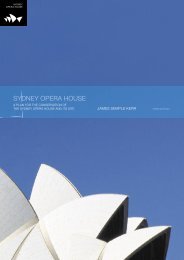July 2 â 3 - Sydney Opera House
July 2 â 3 - Sydney Opera House
July 2 â 3 - Sydney Opera House
Create successful ePaper yourself
Turn your PDF publications into a flip-book with our unique Google optimized e-Paper software.
You might also discuss:<br />
• Who are the main characters?<br />
• What types of characters are in the films? Did you like them? Why or why not?<br />
• Did you care what happened to them? Why or why not?<br />
• Why do you think some films have characters in them that you don’t like?<br />
• Do the films remind you of anything from your own life?<br />
• How do the Indigenous people or characters in the films solve their problems?<br />
• Are there things about some Indigenous people and their lives in the films that surprised you?<br />
• Are these films like the films you usually watch on TV or at the cinema?<br />
• What issues specific to Indigenous culture were raised?<br />
• Is it possible to enjoy films that make you think about important issues?<br />
• What are some possible benefits of viewing these films?<br />
• How did you respond emotionally to the characters and their situations?<br />
How do filmmakers inspire thoughts and feelings?<br />
Some Message Sticks films use live-action to tell stories, while others use documentary. As a class list the<br />
films you viewed under these two headings. Do some films fit more than one category? Explain your<br />
responses.<br />
Select one or two Message Sticks films and discuss techniques used by the filmmakers to create and<br />
communicate meaning. Ask questions such as those that follow.<br />
• Did you expect the film to be live action or documentary? In conveying a story, was the choice a good<br />
one? Why or why not?<br />
• How did the soundtrack help to tell the story? What sounds were most effective in the films? Why<br />
were they effective? Were particular styles of music used? How were they used?<br />
• What images were most effective in the films? Why were they effective?<br />
• How is colour used to help tell the story?<br />
• What camera shots, angles and movements do filmmakers use? How are their choices effective in<br />
helping to tell the story?<br />
• Did the pacing or editing of the film contribute to the story? If so, how?<br />
• How would you describe the film’s atmosphere? How was this atmosphere created?<br />
• Did the filmmakers try to evoke particular feelings in viewers? If so, how?<br />
• What do you know about the filmmakers and their reasons for making the film? Have they made<br />
other films?<br />
• If you could meet the filmmakers what would you want to find out?<br />
What did you learn?<br />
Many Message Sticks films referred to the socio-economic status, cultural beliefs and community values of<br />
Indigenous people in Australia. Some films referred to the history of Indigenous people pre-contact with<br />
Europeans and Indigenous political activism. Addressing each of these topics ask students if they gained any<br />
more insight into Indigenous affairs after viewing the Message Sticks films. Did the films give a fair and<br />
rounded representation of the issues surrounding Indigenous people in the twenty-first century? Encourage<br />
students to explain and to justify their opinions.<br />
Key human values were also strongly reflected in the films, for example, perseverance, compassion,<br />
consideration, courage, generosity, co-operation, friendliness, determination, honesty, enthusiasm,<br />
tolerance, fairness, kindness, forgiveness.<br />
Message Sticks Teacher Kit 2008 ©ACMI 7

















